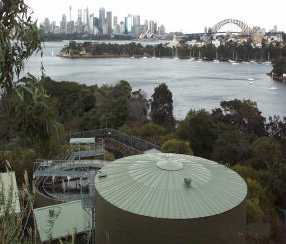A decade ago, the cocktail discharged to Sydney Harbour included one more unusual source of contaminants. Elephants, tigers, camels and giraffes contributed to wastewater discharged from Taronga Zoo on Bradley's Head.
Between 1989 and 1992, Mosman Council’s water quality monitoring showed high faecal coliform counts at beaches adjacent to the zoo. At that time, water from the animal enclosure wash downs and all stormwater was being discharged directly into the harbour causing concerns for public health, beach closures and complaints from local residents.
But the situation was dramatically improved in 1996 with the implementation of a modern water recycling scheme. At a cost of $2.2 million, the scheme was developed with the assistance of Sydney Water, The NSW Department of Health and Clean Up Australia. It now treats between 100 and 650 kilolitres of water onsite each day.

Wastewater at Taronga Zoo consists primarily of stormwater, hose washings from animal enclosures and moat fillings. The first flush runoff and wastewater from enclosure wash downs and moats are now directed through the water recycling plant.
At the plant, the water flows through a screen and grit removal chamber for the removal of large solids. Next it undergoes a biological aeration treatment process to degrade dissolved organic chemicals. Biological treatment is succeeded with a hollow-fibre microfiltration membrane process. In addition to suspended particulates, the microfiltration process is effective for the removal of many bacteria and viruses. Ultraviolet disinfection is then used to inactivate remaining pathogens.
The recycled water is redistributed around the zoo via a separate reticulation system comprising two and a half kilometres of PVC pipe. The water is then reused for lawn and garden irrigation, animal exhibit hose down, moat filling as well as toilet and urinal flushing within the zoo.
A decade on, the water recycling scheme has proved its worth in achieving its original aim of reducing and improving discharged water quality into Sydney Harbour. An additional benefit has been a considerable reduction of use of Sydney’s dwindling fresh potable water supplies. This reduction has led to water bill savings for the zoo of around $70,000 per year.
Taronga Zoo’s water recycling scheme is a relatively simple, but highly effective innovation, providing a great precedent for zoos and other animal-housing operations throughout the world. I'd be keen to hear of any similar good opportunities that you can think of.


No comments:
Post a Comment